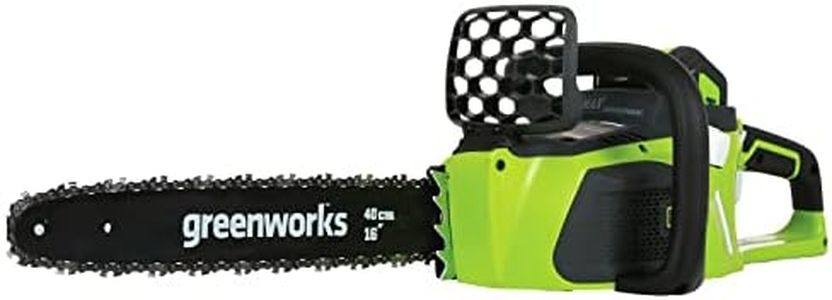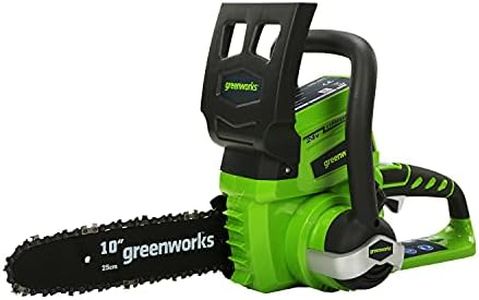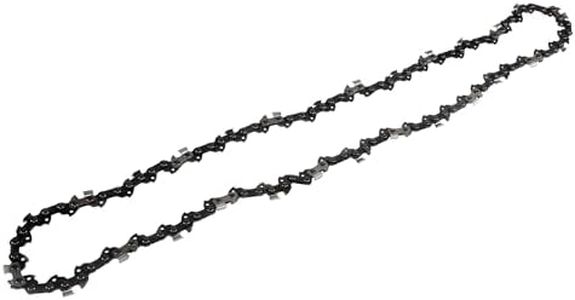We Use CookiesWe use cookies to enhance the security, performance,
functionality and for analytical and promotional activities. By continuing to browse this site you
are agreeing to our privacy policy
4 Best Greenworks Chainsaws
From leading brands and best sellers available on the web.Buying Guide for the Best Greenworks Chainsaws
Choosing a chainsaw, especially from a brand like Greenworks, involves understanding your own needs and matching them to the tool's capabilities. Chainsaws vary widely in terms of power, size, and suitable tasks, so it's important to consider what types of jobs you'll be tackling—such as pruning small trees, cutting firewood, or felling large timber. Each task demands different features, and selecting the right mix will ensure safe and efficient operation. Take the time to understand the specifications, as this will help you select a chainsaw that isn’t too weak or unnecessarily powerful for your needs.Bar LengthBar length refers to the length of the cutting part of the chainsaw and determines the maximum size of wood it can cut in a single pass. Shorter bars, typically 10-12 inches, are great for light tasks like pruning and trimming. Bar lengths of 14-16 inches are more versatile, suitable for cutting small logs or moderate branches. Longer bars, 18 inches or more, handle larger trees but can be bulky and harder to control. Pick a bar length that matches the largest job you expect to do most often, but remember, shorter bars are safer and easier for most homeowners.
Power Source (Battery vs. Corded Electric)Greenworks chainsaws come as battery-powered (cordless) or corded electric models. Battery-powered chainsaws offer portability and freedom from cords, making them ideal for work anywhere on your property, but their runtime is limited by the battery capacity. Corded chainsaws run continuously as long as they're plugged in but are limited by the length of your extension cord. If you have convenient access to power and will work close to your house, electric is simple. If you'll be moving around or need more flexibility, choose battery power. Match this to where and how long you typically work.
Battery Voltage and CapacityVoltage (measured in volts) indicates the potential power of a battery-powered chainsaw, with common options being 24V, 40V, and 60V or higher. Higher voltage means more power for tougher jobs. Capacity, often given in amp-hours (Ah), tells you how long the battery will run on a charge. Lower-voltage and lower-capacity batteries are lighter and good for short, light jobs, while higher specs handle big jobs but add weight. Choose the right balance based on how powerful a tool you need and how long you'll be using it in one go.
WeightA chainsaw’s weight affects how long you can use it comfortably and how easily you can control it. Lightweight saws (around 7-9 pounds) are easier to handle for beginners, for trimming, or for overhead work. Heavier saws provide more power but require more strength and can tire you out faster. If you anticipate long sessions or precise work, lighter is better; for quick, heavy-duty cutting, a little extra weight is manageable if you have the strength.
Chain SpeedChain speed, usually measured in meters or feet per second, reflects how quickly the saw's chain moves around the bar. Higher chain speeds allow for faster and smoother cuts, especially in harder wood or thicker branches. For pruning and light work, a moderate chain speed is fine; for challenging or bigger jobs, higher speeds are beneficial. Match this to the type of wood and the thickness you plan to cut most often.
Tool-Free Chain TensioningThis feature allows you to adjust the tension on the chain without tools, which is handy for quick, easy maintenance. Chains expand and loosen with use, and proper tension is key for safety and cutting performance. If you want convenience and minimal hassle, look for tool-free tensioning, especially if you are new to chainsaw use or want more straightforward maintenance.
Safety FeaturesKey safety features can include chain brakes, hand guards, and low-kickback bars. These prevent accidents and make the saw less likely to cause injury during unexpected events. If you’re an inexperienced user or value maximum safety, prioritize these features.




